Case Study on Cocoa Cartel Stirs Up Global Chocolate Market
VerifiedAdded on 2022/08/12
|17
|3036
|13
AI Summary
Contribute Materials
Your contribution can guide someone’s learning journey. Share your
documents today.
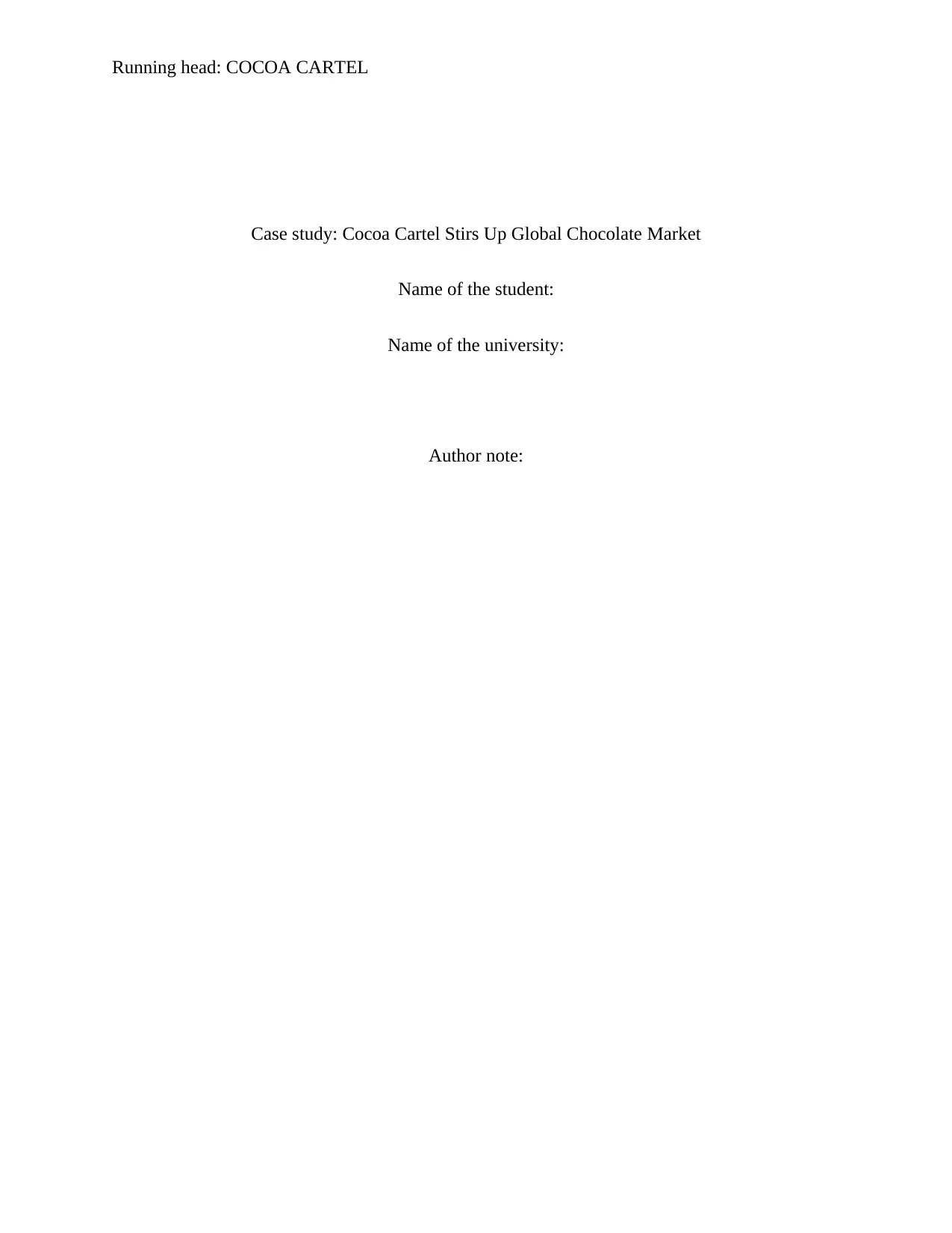
Running head: COCOA CARTEL
Case study: Cocoa Cartel Stirs Up Global Chocolate Market
Name of the student:
Name of the university:
Author note:
Case study: Cocoa Cartel Stirs Up Global Chocolate Market
Name of the student:
Name of the university:
Author note:
Secure Best Marks with AI Grader
Need help grading? Try our AI Grader for instant feedback on your assignments.
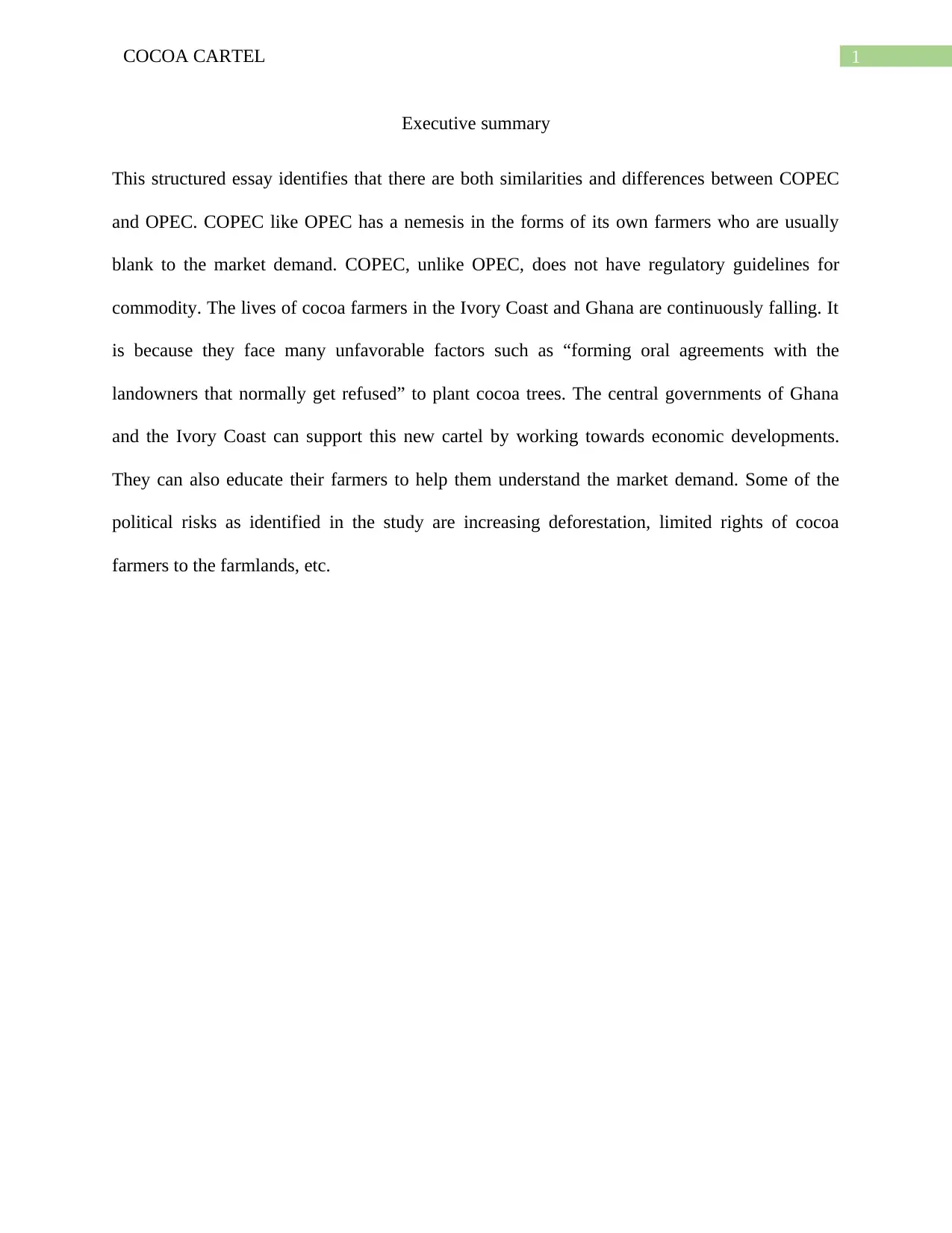
1COCOA CARTEL
Executive summary
This structured essay identifies that there are both similarities and differences between COPEC
and OPEC. COPEC like OPEC has a nemesis in the forms of its own farmers who are usually
blank to the market demand. COPEC, unlike OPEC, does not have regulatory guidelines for
commodity. The lives of cocoa farmers in the Ivory Coast and Ghana are continuously falling. It
is because they face many unfavorable factors such as “forming oral agreements with the
landowners that normally get refused” to plant cocoa trees. The central governments of Ghana
and the Ivory Coast can support this new cartel by working towards economic developments.
They can also educate their farmers to help them understand the market demand. Some of the
political risks as identified in the study are increasing deforestation, limited rights of cocoa
farmers to the farmlands, etc.
Executive summary
This structured essay identifies that there are both similarities and differences between COPEC
and OPEC. COPEC like OPEC has a nemesis in the forms of its own farmers who are usually
blank to the market demand. COPEC, unlike OPEC, does not have regulatory guidelines for
commodity. The lives of cocoa farmers in the Ivory Coast and Ghana are continuously falling. It
is because they face many unfavorable factors such as “forming oral agreements with the
landowners that normally get refused” to plant cocoa trees. The central governments of Ghana
and the Ivory Coast can support this new cartel by working towards economic developments.
They can also educate their farmers to help them understand the market demand. Some of the
political risks as identified in the study are increasing deforestation, limited rights of cocoa
farmers to the farmlands, etc.
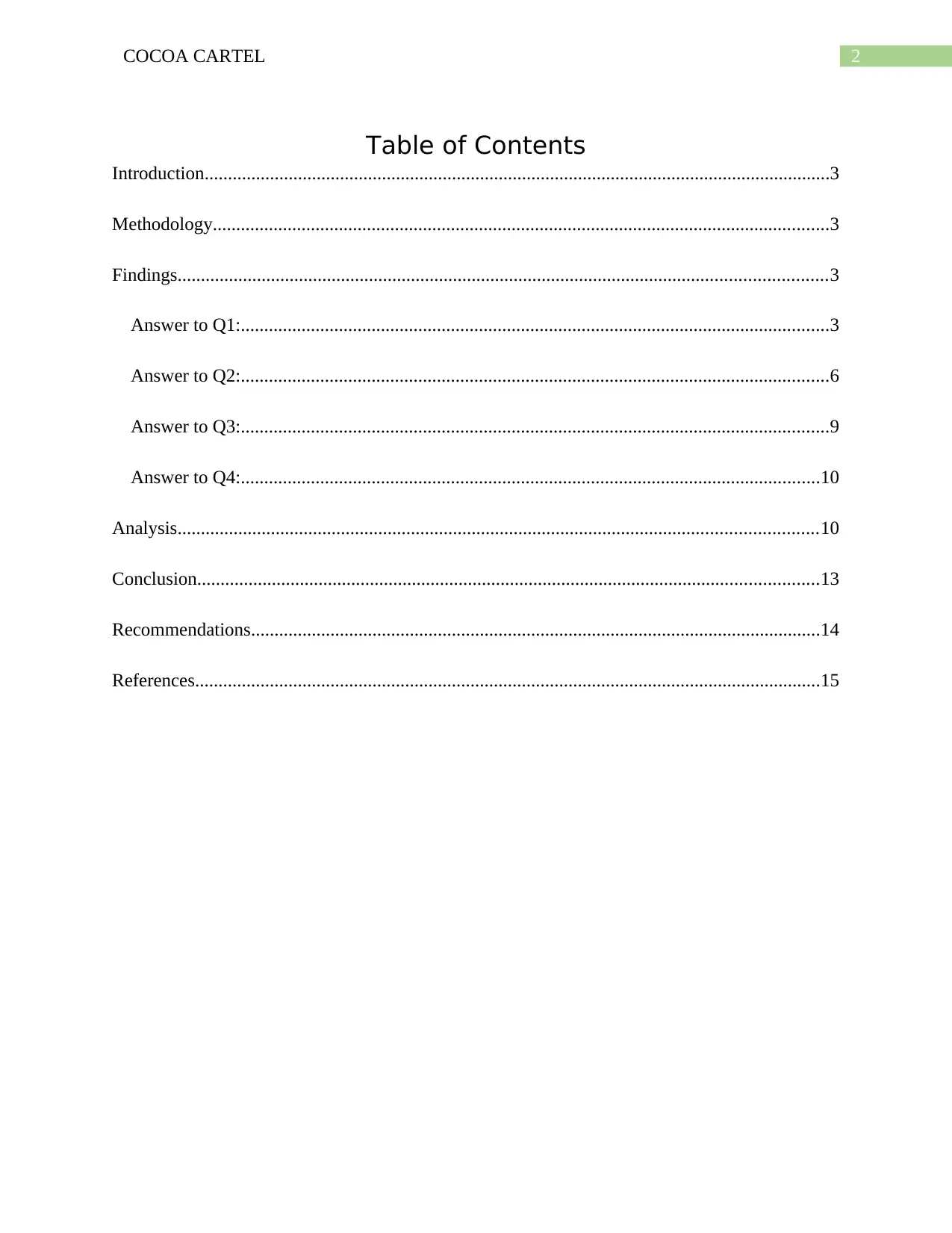
2COCOA CARTEL
Table of Contents
Introduction......................................................................................................................................3
Methodology....................................................................................................................................3
Findings...........................................................................................................................................3
Answer to Q1:..............................................................................................................................3
Answer to Q2:..............................................................................................................................6
Answer to Q3:..............................................................................................................................9
Answer to Q4:............................................................................................................................10
Analysis.........................................................................................................................................10
Conclusion.....................................................................................................................................13
Recommendations..........................................................................................................................14
References......................................................................................................................................15
Table of Contents
Introduction......................................................................................................................................3
Methodology....................................................................................................................................3
Findings...........................................................................................................................................3
Answer to Q1:..............................................................................................................................3
Answer to Q2:..............................................................................................................................6
Answer to Q3:..............................................................................................................................9
Answer to Q4:............................................................................................................................10
Analysis.........................................................................................................................................10
Conclusion.....................................................................................................................................13
Recommendations..........................................................................................................................14
References......................................................................................................................................15
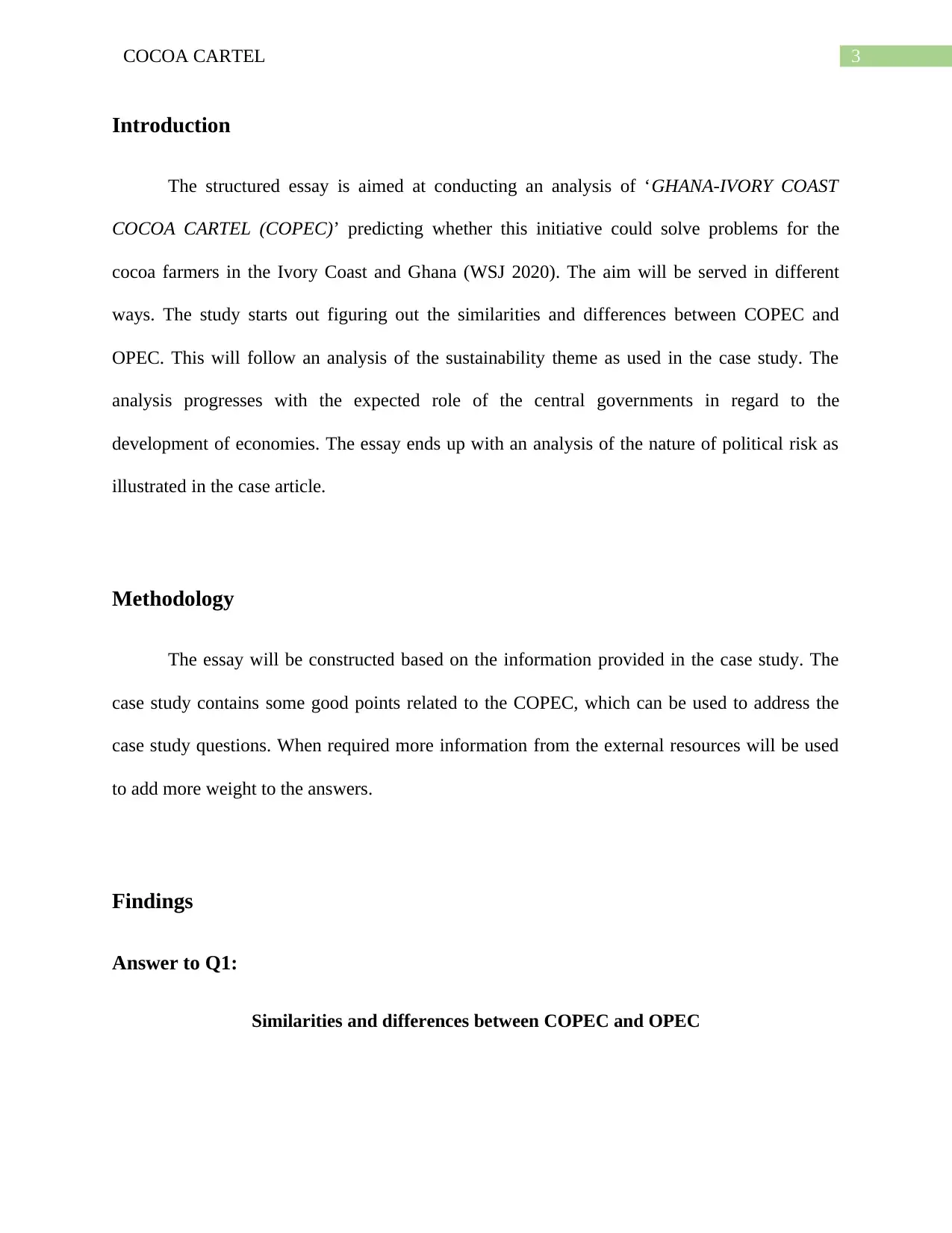
3COCOA CARTEL
Introduction
The structured essay is aimed at conducting an analysis of ‘GHANA-IVORY COAST
COCOA CARTEL (COPEC)’ predicting whether this initiative could solve problems for the
cocoa farmers in the Ivory Coast and Ghana (WSJ 2020). The aim will be served in different
ways. The study starts out figuring out the similarities and differences between COPEC and
OPEC. This will follow an analysis of the sustainability theme as used in the case study. The
analysis progresses with the expected role of the central governments in regard to the
development of economies. The essay ends up with an analysis of the nature of political risk as
illustrated in the case article.
Methodology
The essay will be constructed based on the information provided in the case study. The
case study contains some good points related to the COPEC, which can be used to address the
case study questions. When required more information from the external resources will be used
to add more weight to the answers.
Findings
Answer to Q1:
Similarities and differences between COPEC and OPEC
Introduction
The structured essay is aimed at conducting an analysis of ‘GHANA-IVORY COAST
COCOA CARTEL (COPEC)’ predicting whether this initiative could solve problems for the
cocoa farmers in the Ivory Coast and Ghana (WSJ 2020). The aim will be served in different
ways. The study starts out figuring out the similarities and differences between COPEC and
OPEC. This will follow an analysis of the sustainability theme as used in the case study. The
analysis progresses with the expected role of the central governments in regard to the
development of economies. The essay ends up with an analysis of the nature of political risk as
illustrated in the case article.
Methodology
The essay will be constructed based on the information provided in the case study. The
case study contains some good points related to the COPEC, which can be used to address the
case study questions. When required more information from the external resources will be used
to add more weight to the answers.
Findings
Answer to Q1:
Similarities and differences between COPEC and OPEC
Secure Best Marks with AI Grader
Need help grading? Try our AI Grader for instant feedback on your assignments.
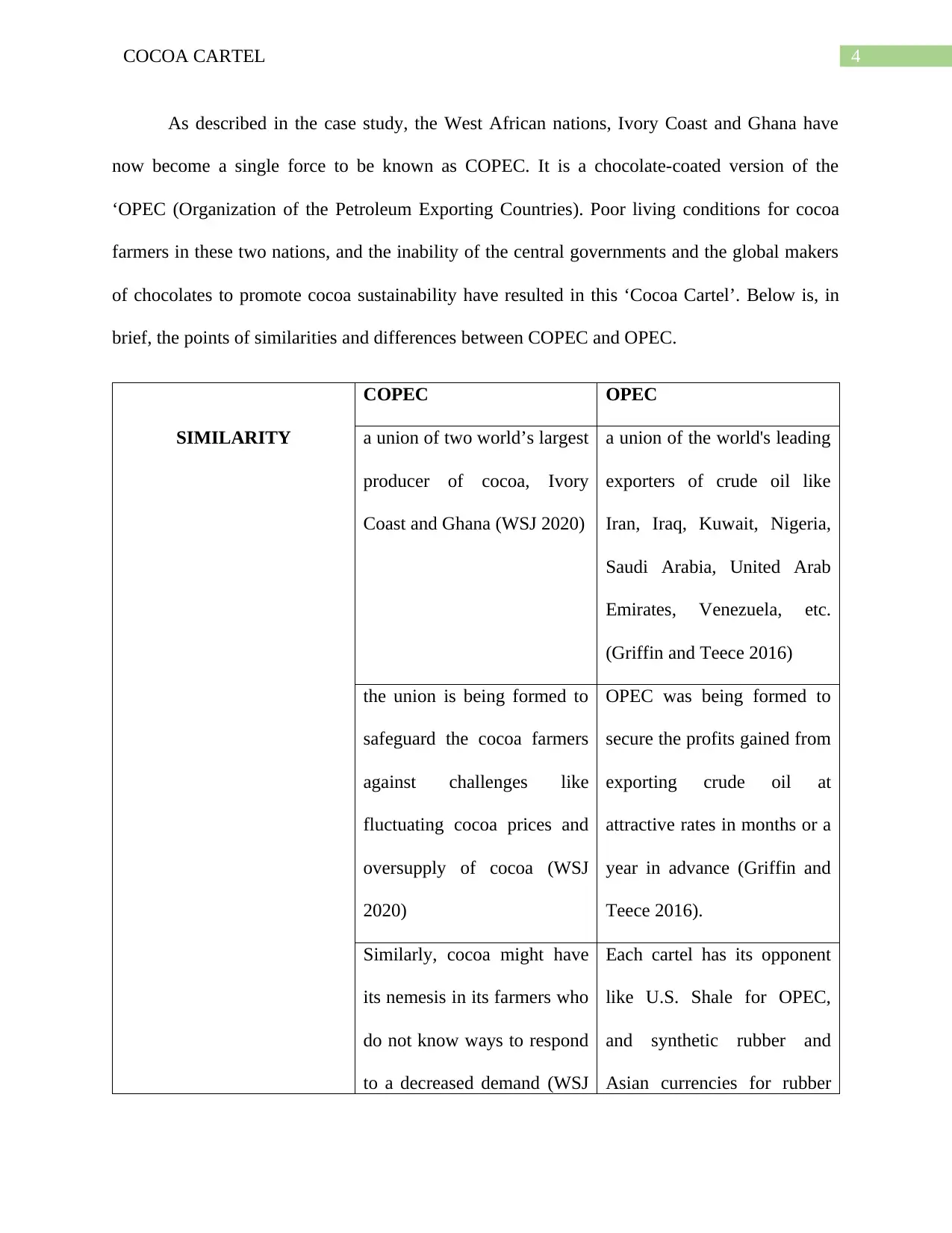
4COCOA CARTEL
As described in the case study, the West African nations, Ivory Coast and Ghana have
now become a single force to be known as COPEC. It is a chocolate-coated version of the
‘OPEC (Organization of the Petroleum Exporting Countries). Poor living conditions for cocoa
farmers in these two nations, and the inability of the central governments and the global makers
of chocolates to promote cocoa sustainability have resulted in this ‘Cocoa Cartel’. Below is, in
brief, the points of similarities and differences between COPEC and OPEC.
COPEC OPEC
SIMILARITY a union of two world’s largest
producer of cocoa, Ivory
Coast and Ghana (WSJ 2020)
a union of the world's leading
exporters of crude oil like
Iran, Iraq, Kuwait, Nigeria,
Saudi Arabia, United Arab
Emirates, Venezuela, etc.
(Griffin and Teece 2016)
the union is being formed to
safeguard the cocoa farmers
against challenges like
fluctuating cocoa prices and
oversupply of cocoa (WSJ
2020)
OPEC was being formed to
secure the profits gained from
exporting crude oil at
attractive rates in months or a
year in advance (Griffin and
Teece 2016).
Similarly, cocoa might have
its nemesis in its farmers who
do not know ways to respond
to a decreased demand (WSJ
Each cartel has its opponent
like U.S. Shale for OPEC,
and synthetic rubber and
Asian currencies for rubber
As described in the case study, the West African nations, Ivory Coast and Ghana have
now become a single force to be known as COPEC. It is a chocolate-coated version of the
‘OPEC (Organization of the Petroleum Exporting Countries). Poor living conditions for cocoa
farmers in these two nations, and the inability of the central governments and the global makers
of chocolates to promote cocoa sustainability have resulted in this ‘Cocoa Cartel’. Below is, in
brief, the points of similarities and differences between COPEC and OPEC.
COPEC OPEC
SIMILARITY a union of two world’s largest
producer of cocoa, Ivory
Coast and Ghana (WSJ 2020)
a union of the world's leading
exporters of crude oil like
Iran, Iraq, Kuwait, Nigeria,
Saudi Arabia, United Arab
Emirates, Venezuela, etc.
(Griffin and Teece 2016)
the union is being formed to
safeguard the cocoa farmers
against challenges like
fluctuating cocoa prices and
oversupply of cocoa (WSJ
2020)
OPEC was being formed to
secure the profits gained from
exporting crude oil at
attractive rates in months or a
year in advance (Griffin and
Teece 2016).
Similarly, cocoa might have
its nemesis in its farmers who
do not know ways to respond
to a decreased demand (WSJ
Each cartel has its opponent
like U.S. Shale for OPEC,
and synthetic rubber and
Asian currencies for rubber
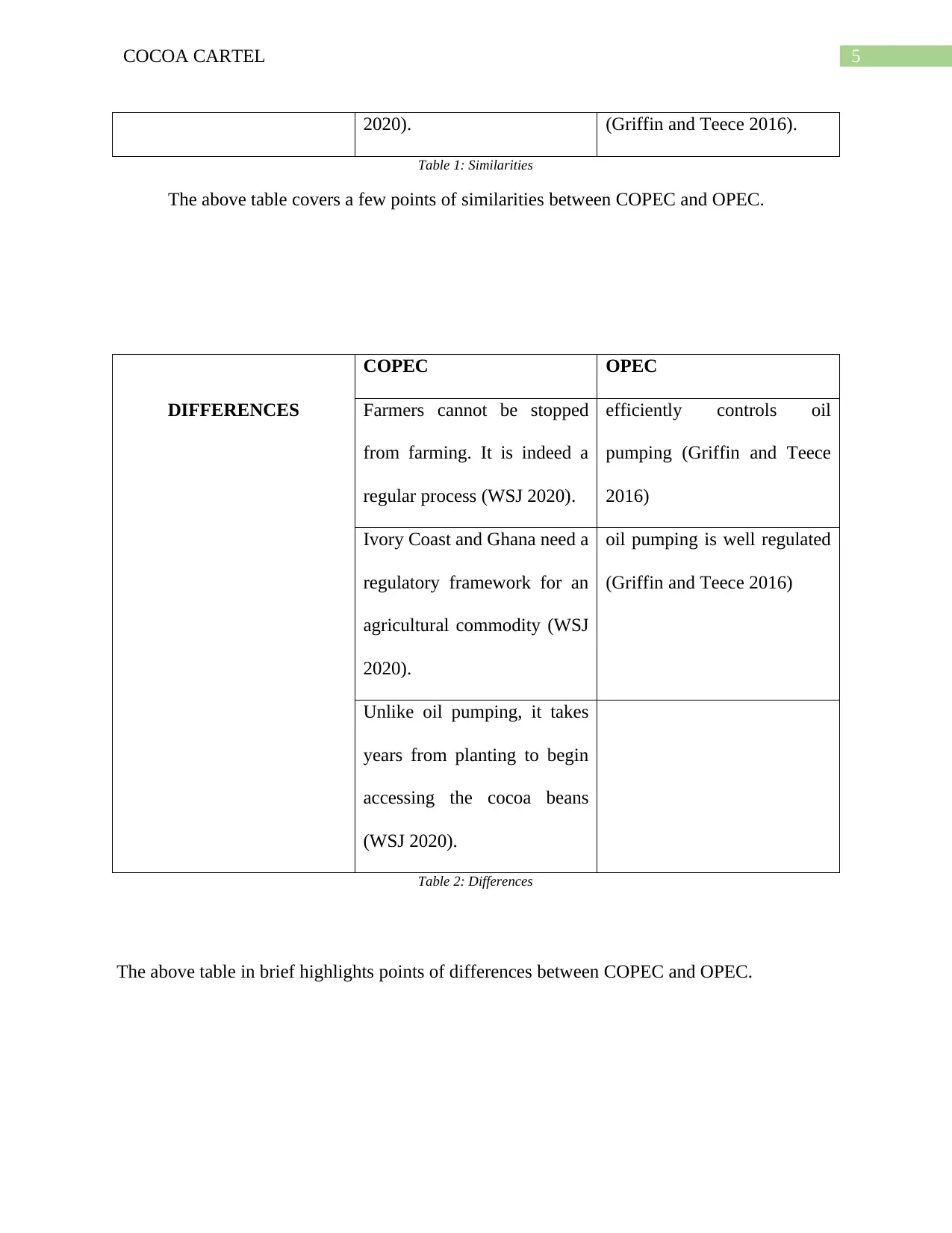
5COCOA CARTEL
2020). (Griffin and Teece 2016).
Table 1: Similarities
The above table covers a few points of similarities between COPEC and OPEC.
COPEC OPEC
DIFFERENCES Farmers cannot be stopped
from farming. It is indeed a
regular process (WSJ 2020).
efficiently controls oil
pumping (Griffin and Teece
2016)
Ivory Coast and Ghana need a
regulatory framework for an
agricultural commodity (WSJ
2020).
oil pumping is well regulated
(Griffin and Teece 2016)
Unlike oil pumping, it takes
years from planting to begin
accessing the cocoa beans
(WSJ 2020).
Table 2: Differences
The above table in brief highlights points of differences between COPEC and OPEC.
2020). (Griffin and Teece 2016).
Table 1: Similarities
The above table covers a few points of similarities between COPEC and OPEC.
COPEC OPEC
DIFFERENCES Farmers cannot be stopped
from farming. It is indeed a
regular process (WSJ 2020).
efficiently controls oil
pumping (Griffin and Teece
2016)
Ivory Coast and Ghana need a
regulatory framework for an
agricultural commodity (WSJ
2020).
oil pumping is well regulated
(Griffin and Teece 2016)
Unlike oil pumping, it takes
years from planting to begin
accessing the cocoa beans
(WSJ 2020).
Table 2: Differences
The above table in brief highlights points of differences between COPEC and OPEC.
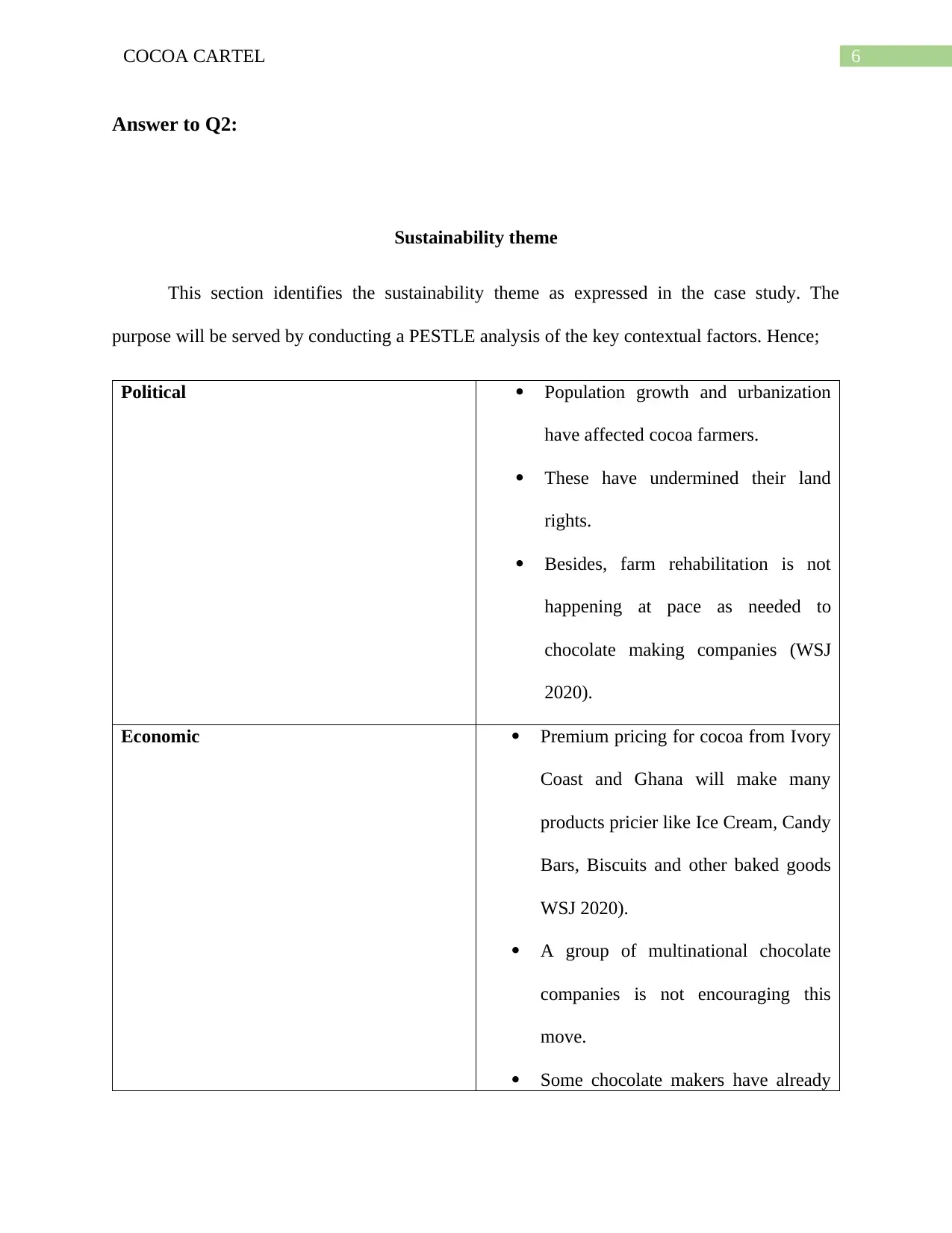
6COCOA CARTEL
Answer to Q2:
Sustainability theme
This section identifies the sustainability theme as expressed in the case study. The
purpose will be served by conducting a PESTLE analysis of the key contextual factors. Hence;
Political Population growth and urbanization
have affected cocoa farmers.
These have undermined their land
rights.
Besides, farm rehabilitation is not
happening at pace as needed to
chocolate making companies (WSJ
2020).
Economic Premium pricing for cocoa from Ivory
Coast and Ghana will make many
products pricier like Ice Cream, Candy
Bars, Biscuits and other baked goods
WSJ 2020).
A group of multinational chocolate
companies is not encouraging this
move.
Some chocolate makers have already
Answer to Q2:
Sustainability theme
This section identifies the sustainability theme as expressed in the case study. The
purpose will be served by conducting a PESTLE analysis of the key contextual factors. Hence;
Political Population growth and urbanization
have affected cocoa farmers.
These have undermined their land
rights.
Besides, farm rehabilitation is not
happening at pace as needed to
chocolate making companies (WSJ
2020).
Economic Premium pricing for cocoa from Ivory
Coast and Ghana will make many
products pricier like Ice Cream, Candy
Bars, Biscuits and other baked goods
WSJ 2020).
A group of multinational chocolate
companies is not encouraging this
move.
Some chocolate makers have already
Paraphrase This Document
Need a fresh take? Get an instant paraphrase of this document with our AI Paraphraser
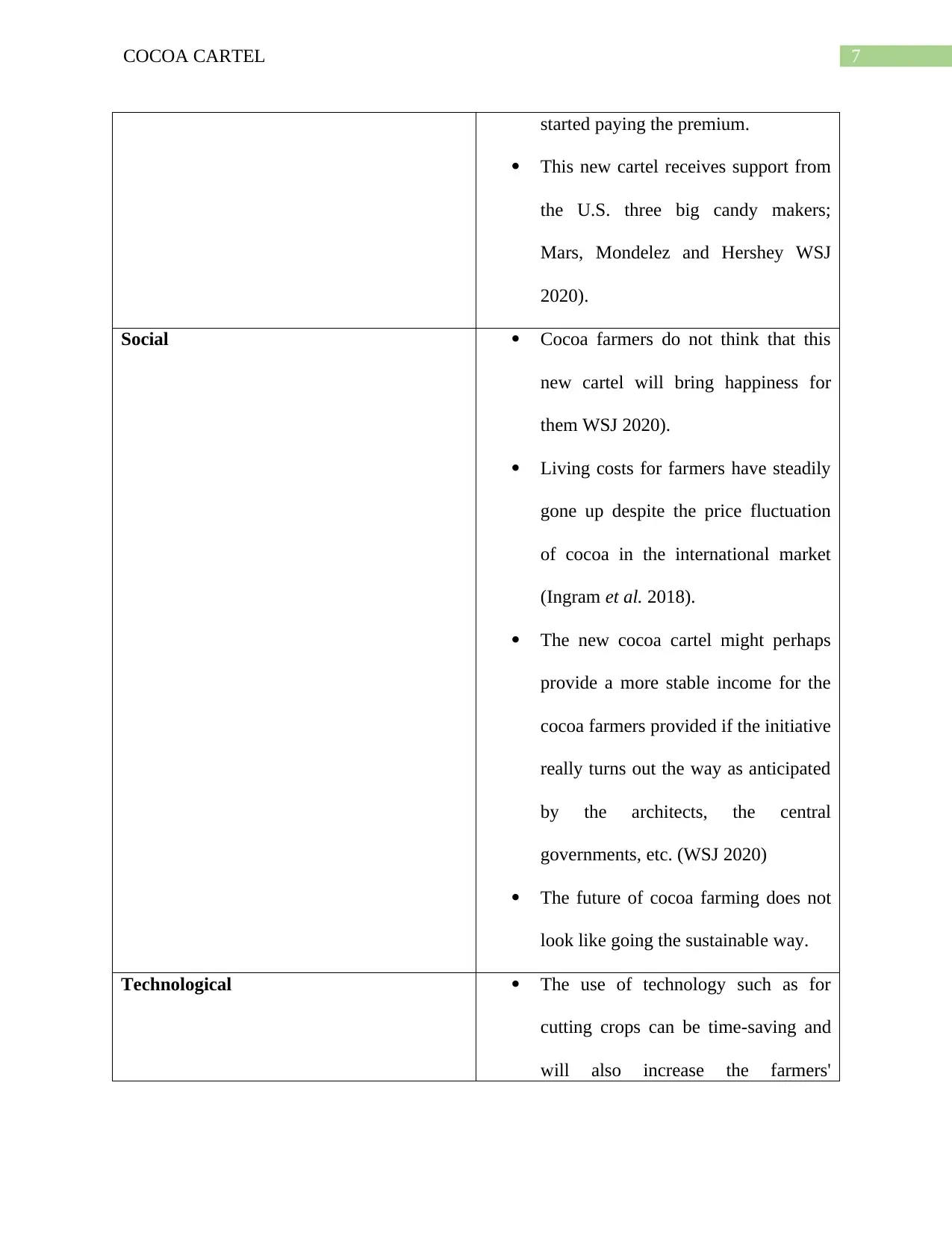
7COCOA CARTEL
started paying the premium.
This new cartel receives support from
the U.S. three big candy makers;
Mars, Mondelez and Hershey WSJ
2020).
Social Cocoa farmers do not think that this
new cartel will bring happiness for
them WSJ 2020).
Living costs for farmers have steadily
gone up despite the price fluctuation
of cocoa in the international market
(Ingram et al. 2018).
The new cocoa cartel might perhaps
provide a more stable income for the
cocoa farmers provided if the initiative
really turns out the way as anticipated
by the architects, the central
governments, etc. (WSJ 2020)
The future of cocoa farming does not
look like going the sustainable way.
Technological The use of technology such as for
cutting crops can be time-saving and
will also increase the farmers'
started paying the premium.
This new cartel receives support from
the U.S. three big candy makers;
Mars, Mondelez and Hershey WSJ
2020).
Social Cocoa farmers do not think that this
new cartel will bring happiness for
them WSJ 2020).
Living costs for farmers have steadily
gone up despite the price fluctuation
of cocoa in the international market
(Ingram et al. 2018).
The new cocoa cartel might perhaps
provide a more stable income for the
cocoa farmers provided if the initiative
really turns out the way as anticipated
by the architects, the central
governments, etc. (WSJ 2020)
The future of cocoa farming does not
look like going the sustainable way.
Technological The use of technology such as for
cutting crops can be time-saving and
will also increase the farmers'
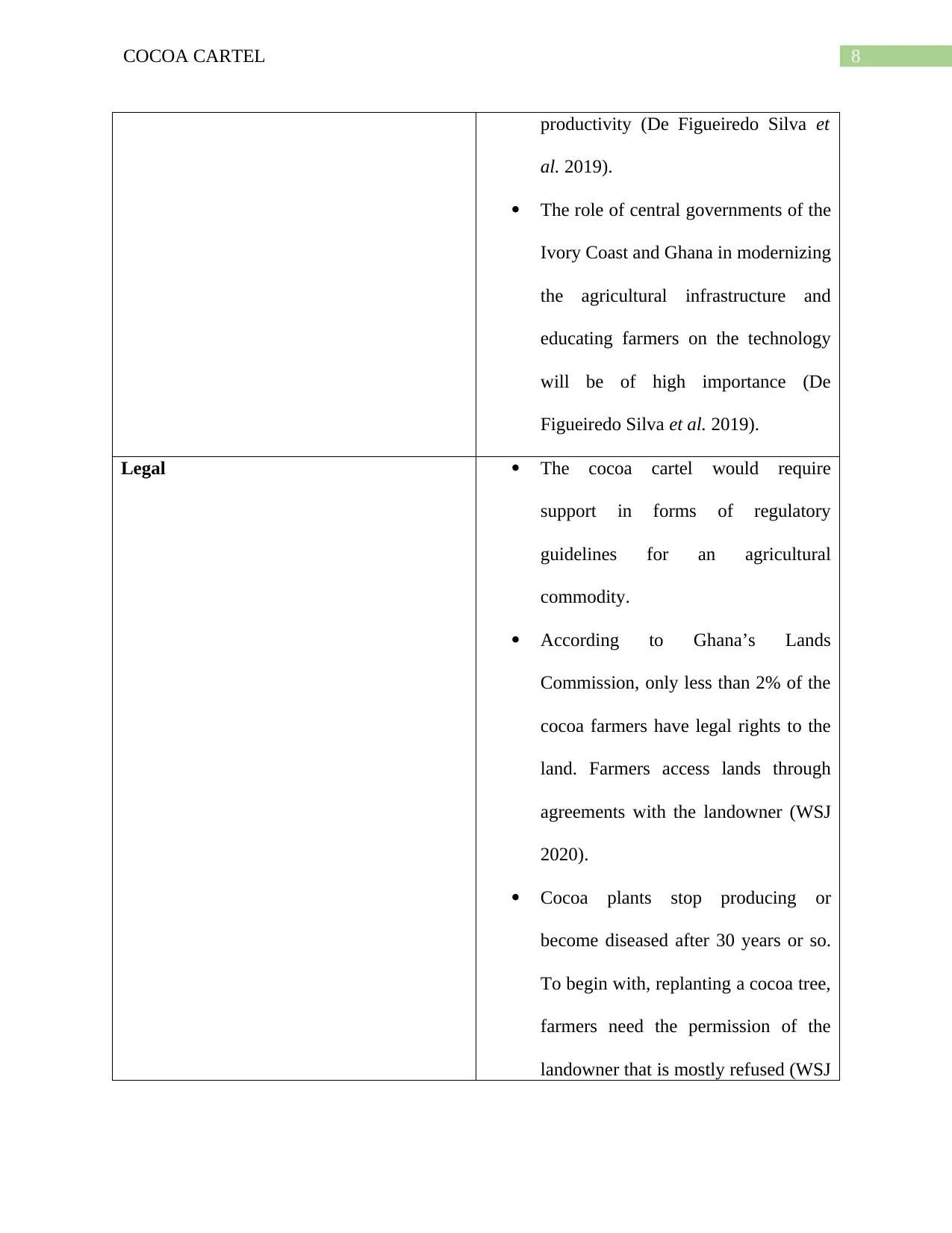
8COCOA CARTEL
productivity (De Figueiredo Silva et
al. 2019).
The role of central governments of the
Ivory Coast and Ghana in modernizing
the agricultural infrastructure and
educating farmers on the technology
will be of high importance (De
Figueiredo Silva et al. 2019).
Legal The cocoa cartel would require
support in forms of regulatory
guidelines for an agricultural
commodity.
According to Ghana’s Lands
Commission, only less than 2% of the
cocoa farmers have legal rights to the
land. Farmers access lands through
agreements with the landowner (WSJ
2020).
Cocoa plants stop producing or
become diseased after 30 years or so.
To begin with, replanting a cocoa tree,
farmers need the permission of the
landowner that is mostly refused (WSJ
productivity (De Figueiredo Silva et
al. 2019).
The role of central governments of the
Ivory Coast and Ghana in modernizing
the agricultural infrastructure and
educating farmers on the technology
will be of high importance (De
Figueiredo Silva et al. 2019).
Legal The cocoa cartel would require
support in forms of regulatory
guidelines for an agricultural
commodity.
According to Ghana’s Lands
Commission, only less than 2% of the
cocoa farmers have legal rights to the
land. Farmers access lands through
agreements with the landowner (WSJ
2020).
Cocoa plants stop producing or
become diseased after 30 years or so.
To begin with, replanting a cocoa tree,
farmers need the permission of the
landowner that is mostly refused (WSJ
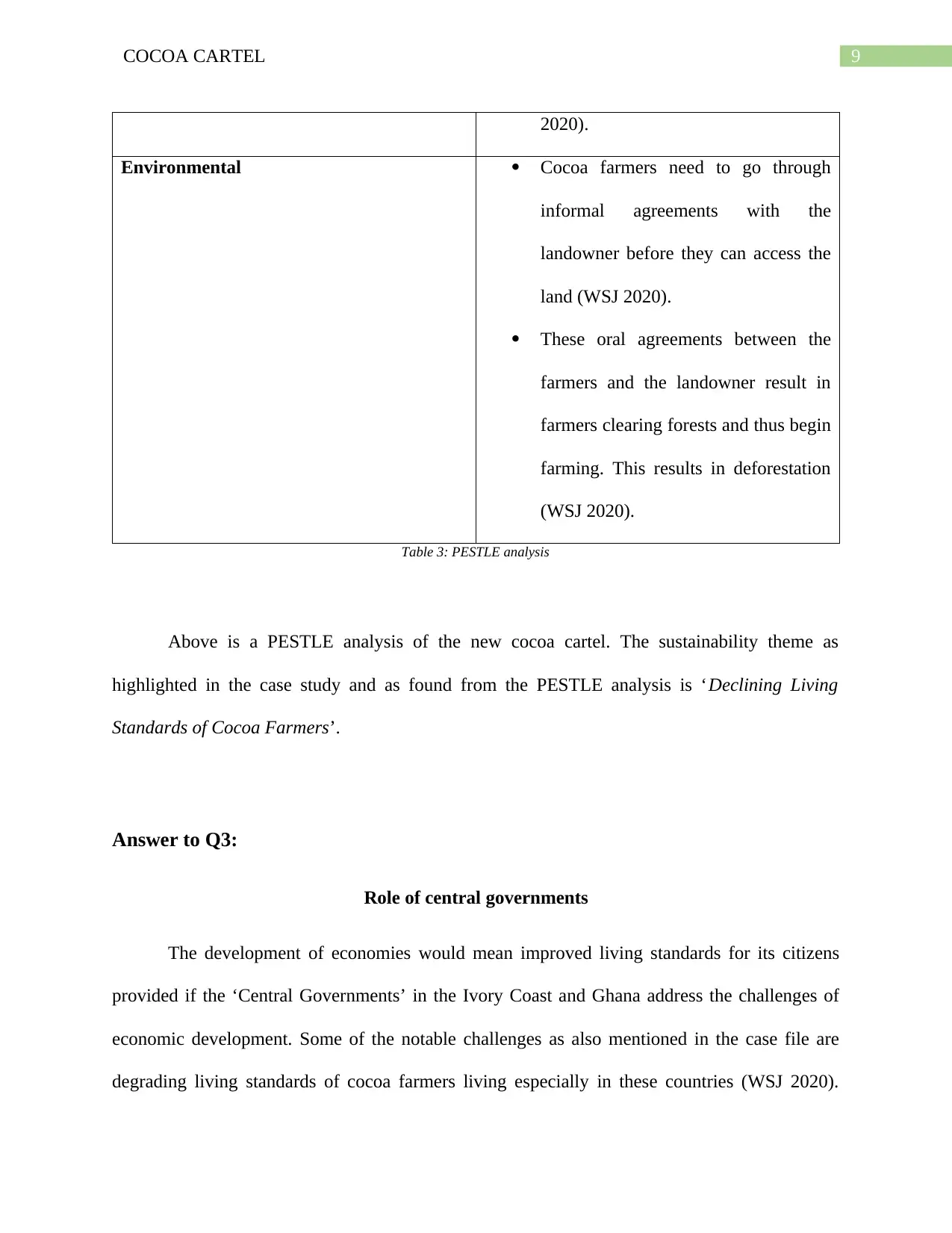
9COCOA CARTEL
2020).
Environmental Cocoa farmers need to go through
informal agreements with the
landowner before they can access the
land (WSJ 2020).
These oral agreements between the
farmers and the landowner result in
farmers clearing forests and thus begin
farming. This results in deforestation
(WSJ 2020).
Table 3: PESTLE analysis
Above is a PESTLE analysis of the new cocoa cartel. The sustainability theme as
highlighted in the case study and as found from the PESTLE analysis is ‘Declining Living
Standards of Cocoa Farmers’.
Answer to Q3:
Role of central governments
The development of economies would mean improved living standards for its citizens
provided if the ‘Central Governments’ in the Ivory Coast and Ghana address the challenges of
economic development. Some of the notable challenges as also mentioned in the case file are
degrading living standards of cocoa farmers living especially in these countries (WSJ 2020).
2020).
Environmental Cocoa farmers need to go through
informal agreements with the
landowner before they can access the
land (WSJ 2020).
These oral agreements between the
farmers and the landowner result in
farmers clearing forests and thus begin
farming. This results in deforestation
(WSJ 2020).
Table 3: PESTLE analysis
Above is a PESTLE analysis of the new cocoa cartel. The sustainability theme as
highlighted in the case study and as found from the PESTLE analysis is ‘Declining Living
Standards of Cocoa Farmers’.
Answer to Q3:
Role of central governments
The development of economies would mean improved living standards for its citizens
provided if the ‘Central Governments’ in the Ivory Coast and Ghana address the challenges of
economic development. Some of the notable challenges as also mentioned in the case file are
degrading living standards of cocoa farmers living especially in these countries (WSJ 2020).
Secure Best Marks with AI Grader
Need help grading? Try our AI Grader for instant feedback on your assignments.
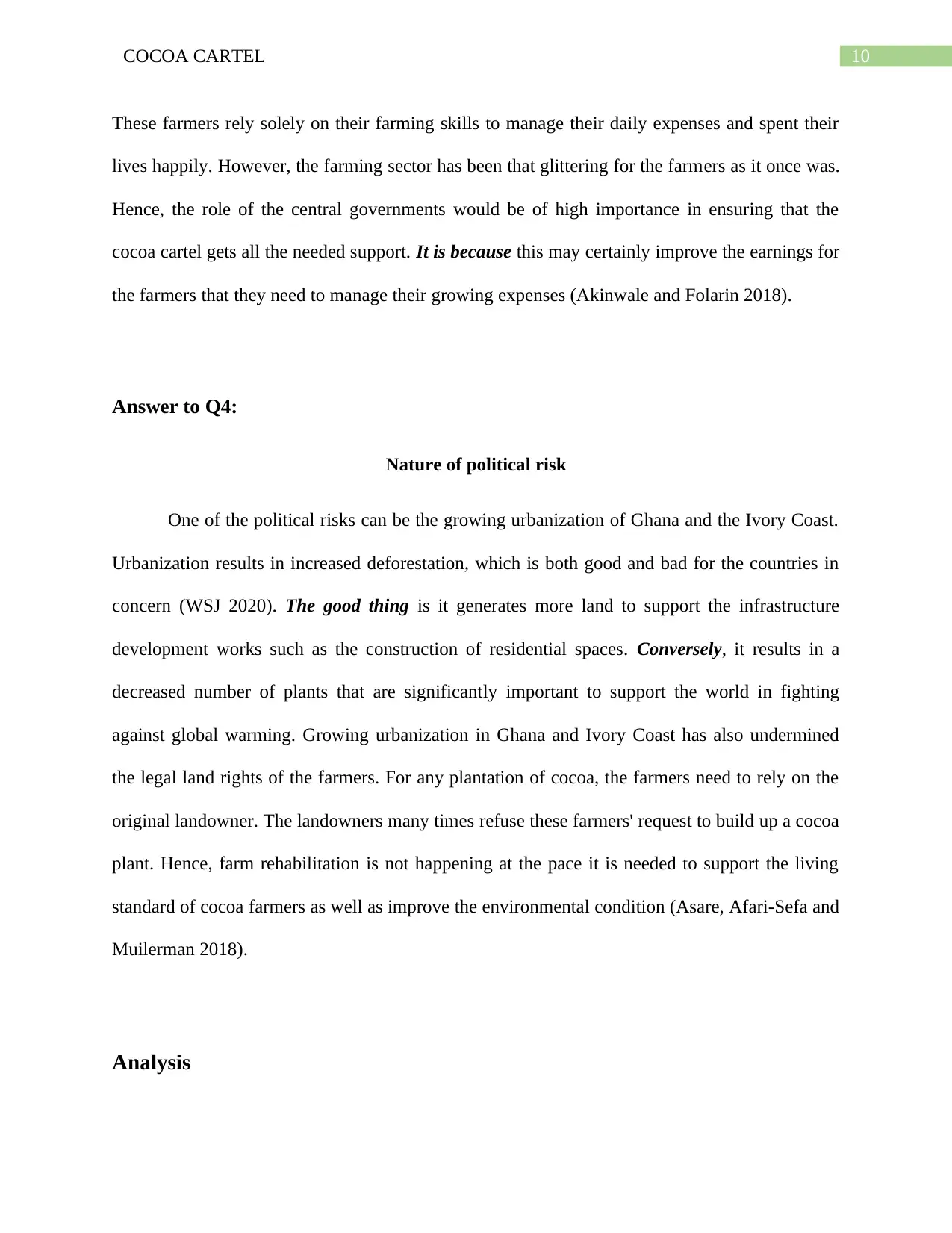
10COCOA CARTEL
These farmers rely solely on their farming skills to manage their daily expenses and spent their
lives happily. However, the farming sector has been that glittering for the farmers as it once was.
Hence, the role of the central governments would be of high importance in ensuring that the
cocoa cartel gets all the needed support. It is because this may certainly improve the earnings for
the farmers that they need to manage their growing expenses (Akinwale and Folarin 2018).
Answer to Q4:
Nature of political risk
One of the political risks can be the growing urbanization of Ghana and the Ivory Coast.
Urbanization results in increased deforestation, which is both good and bad for the countries in
concern (WSJ 2020). The good thing is it generates more land to support the infrastructure
development works such as the construction of residential spaces. Conversely, it results in a
decreased number of plants that are significantly important to support the world in fighting
against global warming. Growing urbanization in Ghana and Ivory Coast has also undermined
the legal land rights of the farmers. For any plantation of cocoa, the farmers need to rely on the
original landowner. The landowners many times refuse these farmers' request to build up a cocoa
plant. Hence, farm rehabilitation is not happening at the pace it is needed to support the living
standard of cocoa farmers as well as improve the environmental condition (Asare, Afari-Sefa and
Muilerman 2018).
Analysis
These farmers rely solely on their farming skills to manage their daily expenses and spent their
lives happily. However, the farming sector has been that glittering for the farmers as it once was.
Hence, the role of the central governments would be of high importance in ensuring that the
cocoa cartel gets all the needed support. It is because this may certainly improve the earnings for
the farmers that they need to manage their growing expenses (Akinwale and Folarin 2018).
Answer to Q4:
Nature of political risk
One of the political risks can be the growing urbanization of Ghana and the Ivory Coast.
Urbanization results in increased deforestation, which is both good and bad for the countries in
concern (WSJ 2020). The good thing is it generates more land to support the infrastructure
development works such as the construction of residential spaces. Conversely, it results in a
decreased number of plants that are significantly important to support the world in fighting
against global warming. Growing urbanization in Ghana and Ivory Coast has also undermined
the legal land rights of the farmers. For any plantation of cocoa, the farmers need to rely on the
original landowner. The landowners many times refuse these farmers' request to build up a cocoa
plant. Hence, farm rehabilitation is not happening at the pace it is needed to support the living
standard of cocoa farmers as well as improve the environmental condition (Asare, Afari-Sefa and
Muilerman 2018).
Analysis
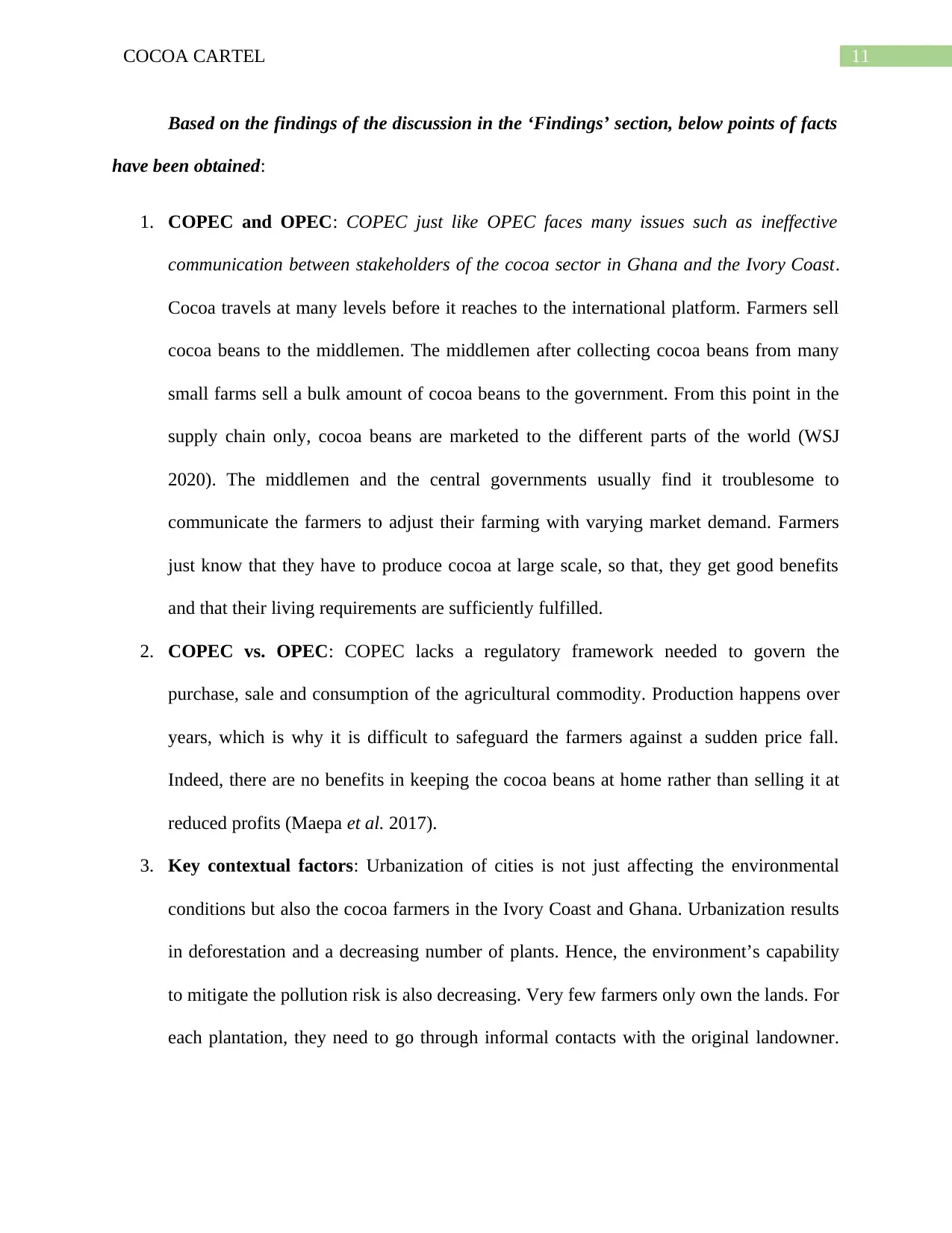
11COCOA CARTEL
Based on the findings of the discussion in the ‘Findings’ section, below points of facts
have been obtained:
1. COPEC and OPEC: COPEC just like OPEC faces many issues such as ineffective
communication between stakeholders of the cocoa sector in Ghana and the Ivory Coast.
Cocoa travels at many levels before it reaches to the international platform. Farmers sell
cocoa beans to the middlemen. The middlemen after collecting cocoa beans from many
small farms sell a bulk amount of cocoa beans to the government. From this point in the
supply chain only, cocoa beans are marketed to the different parts of the world (WSJ
2020). The middlemen and the central governments usually find it troublesome to
communicate the farmers to adjust their farming with varying market demand. Farmers
just know that they have to produce cocoa at large scale, so that, they get good benefits
and that their living requirements are sufficiently fulfilled.
2. COPEC vs. OPEC: COPEC lacks a regulatory framework needed to govern the
purchase, sale and consumption of the agricultural commodity. Production happens over
years, which is why it is difficult to safeguard the farmers against a sudden price fall.
Indeed, there are no benefits in keeping the cocoa beans at home rather than selling it at
reduced profits (Maepa et al. 2017).
3. Key contextual factors: Urbanization of cities is not just affecting the environmental
conditions but also the cocoa farmers in the Ivory Coast and Ghana. Urbanization results
in deforestation and a decreasing number of plants. Hence, the environment’s capability
to mitigate the pollution risk is also decreasing. Very few farmers only own the lands. For
each plantation, they need to go through informal contacts with the original landowner.
Based on the findings of the discussion in the ‘Findings’ section, below points of facts
have been obtained:
1. COPEC and OPEC: COPEC just like OPEC faces many issues such as ineffective
communication between stakeholders of the cocoa sector in Ghana and the Ivory Coast.
Cocoa travels at many levels before it reaches to the international platform. Farmers sell
cocoa beans to the middlemen. The middlemen after collecting cocoa beans from many
small farms sell a bulk amount of cocoa beans to the government. From this point in the
supply chain only, cocoa beans are marketed to the different parts of the world (WSJ
2020). The middlemen and the central governments usually find it troublesome to
communicate the farmers to adjust their farming with varying market demand. Farmers
just know that they have to produce cocoa at large scale, so that, they get good benefits
and that their living requirements are sufficiently fulfilled.
2. COPEC vs. OPEC: COPEC lacks a regulatory framework needed to govern the
purchase, sale and consumption of the agricultural commodity. Production happens over
years, which is why it is difficult to safeguard the farmers against a sudden price fall.
Indeed, there are no benefits in keeping the cocoa beans at home rather than selling it at
reduced profits (Maepa et al. 2017).
3. Key contextual factors: Urbanization of cities is not just affecting the environmental
conditions but also the cocoa farmers in the Ivory Coast and Ghana. Urbanization results
in deforestation and a decreasing number of plants. Hence, the environment’s capability
to mitigate the pollution risk is also decreasing. Very few farmers only own the lands. For
each plantation, they need to go through informal contacts with the original landowner.
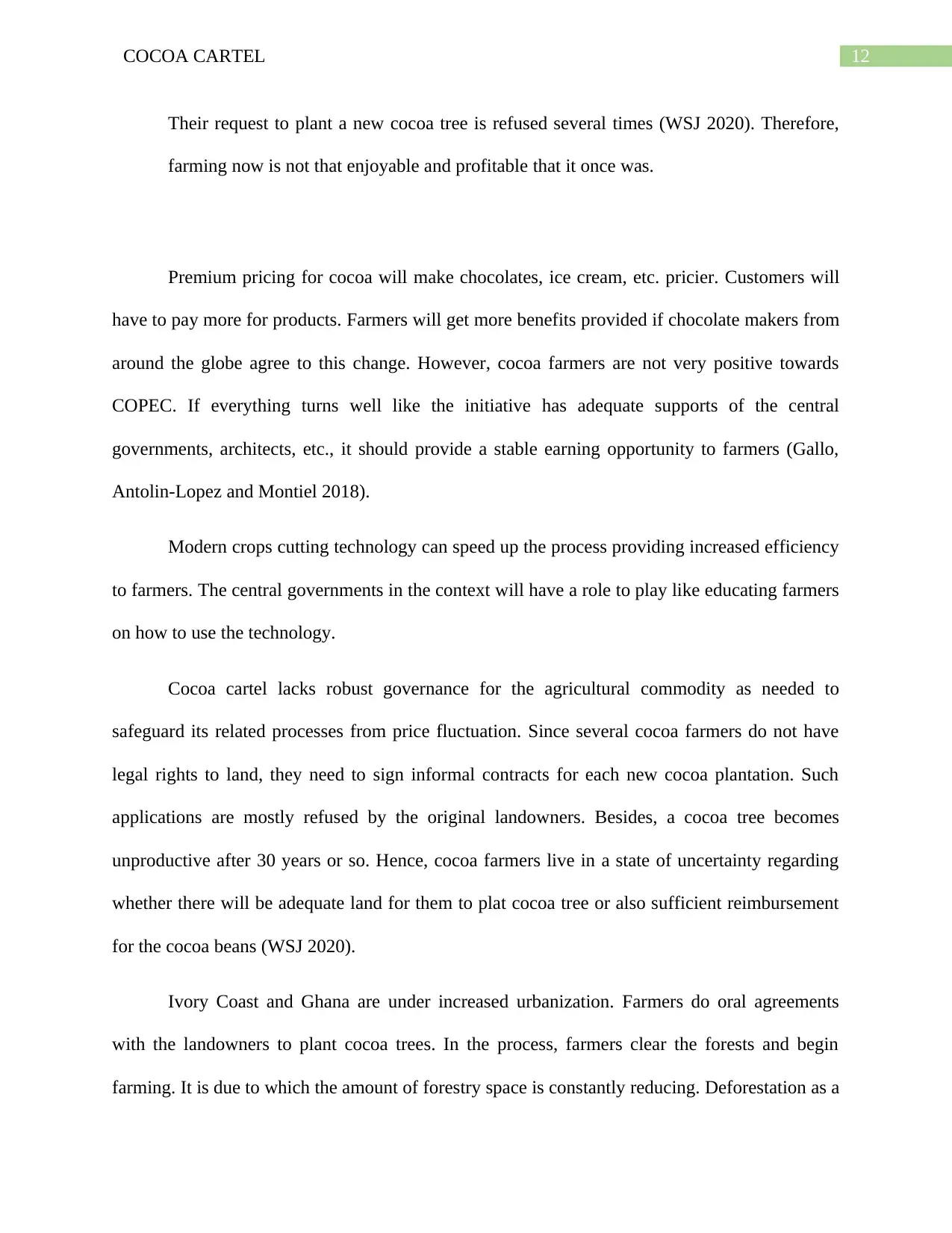
12COCOA CARTEL
Their request to plant a new cocoa tree is refused several times (WSJ 2020). Therefore,
farming now is not that enjoyable and profitable that it once was.
Premium pricing for cocoa will make chocolates, ice cream, etc. pricier. Customers will
have to pay more for products. Farmers will get more benefits provided if chocolate makers from
around the globe agree to this change. However, cocoa farmers are not very positive towards
COPEC. If everything turns well like the initiative has adequate supports of the central
governments, architects, etc., it should provide a stable earning opportunity to farmers (Gallo,
Antolin-Lopez and Montiel 2018).
Modern crops cutting technology can speed up the process providing increased efficiency
to farmers. The central governments in the context will have a role to play like educating farmers
on how to use the technology.
Cocoa cartel lacks robust governance for the agricultural commodity as needed to
safeguard its related processes from price fluctuation. Since several cocoa farmers do not have
legal rights to land, they need to sign informal contracts for each new cocoa plantation. Such
applications are mostly refused by the original landowners. Besides, a cocoa tree becomes
unproductive after 30 years or so. Hence, cocoa farmers live in a state of uncertainty regarding
whether there will be adequate land for them to plat cocoa tree or also sufficient reimbursement
for the cocoa beans (WSJ 2020).
Ivory Coast and Ghana are under increased urbanization. Farmers do oral agreements
with the landowners to plant cocoa trees. In the process, farmers clear the forests and begin
farming. It is due to which the amount of forestry space is constantly reducing. Deforestation as a
Their request to plant a new cocoa tree is refused several times (WSJ 2020). Therefore,
farming now is not that enjoyable and profitable that it once was.
Premium pricing for cocoa will make chocolates, ice cream, etc. pricier. Customers will
have to pay more for products. Farmers will get more benefits provided if chocolate makers from
around the globe agree to this change. However, cocoa farmers are not very positive towards
COPEC. If everything turns well like the initiative has adequate supports of the central
governments, architects, etc., it should provide a stable earning opportunity to farmers (Gallo,
Antolin-Lopez and Montiel 2018).
Modern crops cutting technology can speed up the process providing increased efficiency
to farmers. The central governments in the context will have a role to play like educating farmers
on how to use the technology.
Cocoa cartel lacks robust governance for the agricultural commodity as needed to
safeguard its related processes from price fluctuation. Since several cocoa farmers do not have
legal rights to land, they need to sign informal contracts for each new cocoa plantation. Such
applications are mostly refused by the original landowners. Besides, a cocoa tree becomes
unproductive after 30 years or so. Hence, cocoa farmers live in a state of uncertainty regarding
whether there will be adequate land for them to plat cocoa tree or also sufficient reimbursement
for the cocoa beans (WSJ 2020).
Ivory Coast and Ghana are under increased urbanization. Farmers do oral agreements
with the landowners to plant cocoa trees. In the process, farmers clear the forests and begin
farming. It is due to which the amount of forestry space is constantly reducing. Deforestation as a
Paraphrase This Document
Need a fresh take? Get an instant paraphrase of this document with our AI Paraphraser
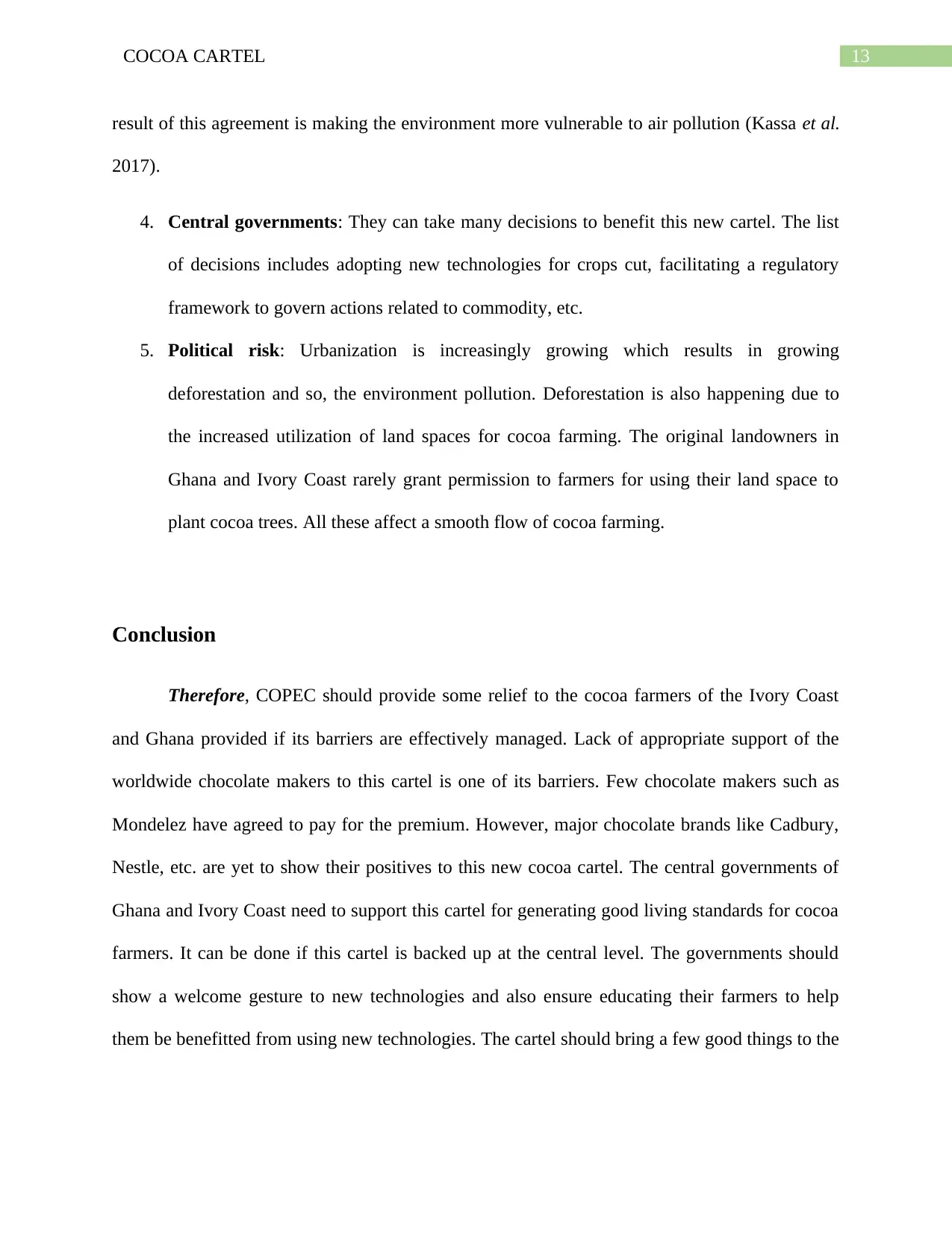
13COCOA CARTEL
result of this agreement is making the environment more vulnerable to air pollution (Kassa et al.
2017).
4. Central governments: They can take many decisions to benefit this new cartel. The list
of decisions includes adopting new technologies for crops cut, facilitating a regulatory
framework to govern actions related to commodity, etc.
5. Political risk: Urbanization is increasingly growing which results in growing
deforestation and so, the environment pollution. Deforestation is also happening due to
the increased utilization of land spaces for cocoa farming. The original landowners in
Ghana and Ivory Coast rarely grant permission to farmers for using their land space to
plant cocoa trees. All these affect a smooth flow of cocoa farming.
Conclusion
Therefore, COPEC should provide some relief to the cocoa farmers of the Ivory Coast
and Ghana provided if its barriers are effectively managed. Lack of appropriate support of the
worldwide chocolate makers to this cartel is one of its barriers. Few chocolate makers such as
Mondelez have agreed to pay for the premium. However, major chocolate brands like Cadbury,
Nestle, etc. are yet to show their positives to this new cocoa cartel. The central governments of
Ghana and Ivory Coast need to support this cartel for generating good living standards for cocoa
farmers. It can be done if this cartel is backed up at the central level. The governments should
show a welcome gesture to new technologies and also ensure educating their farmers to help
them be benefitted from using new technologies. The cartel should bring a few good things to the
result of this agreement is making the environment more vulnerable to air pollution (Kassa et al.
2017).
4. Central governments: They can take many decisions to benefit this new cartel. The list
of decisions includes adopting new technologies for crops cut, facilitating a regulatory
framework to govern actions related to commodity, etc.
5. Political risk: Urbanization is increasingly growing which results in growing
deforestation and so, the environment pollution. Deforestation is also happening due to
the increased utilization of land spaces for cocoa farming. The original landowners in
Ghana and Ivory Coast rarely grant permission to farmers for using their land space to
plant cocoa trees. All these affect a smooth flow of cocoa farming.
Conclusion
Therefore, COPEC should provide some relief to the cocoa farmers of the Ivory Coast
and Ghana provided if its barriers are effectively managed. Lack of appropriate support of the
worldwide chocolate makers to this cartel is one of its barriers. Few chocolate makers such as
Mondelez have agreed to pay for the premium. However, major chocolate brands like Cadbury,
Nestle, etc. are yet to show their positives to this new cocoa cartel. The central governments of
Ghana and Ivory Coast need to support this cartel for generating good living standards for cocoa
farmers. It can be done if this cartel is backed up at the central level. The governments should
show a welcome gesture to new technologies and also ensure educating their farmers to help
them be benefitted from using new technologies. The cartel should bring a few good things to the
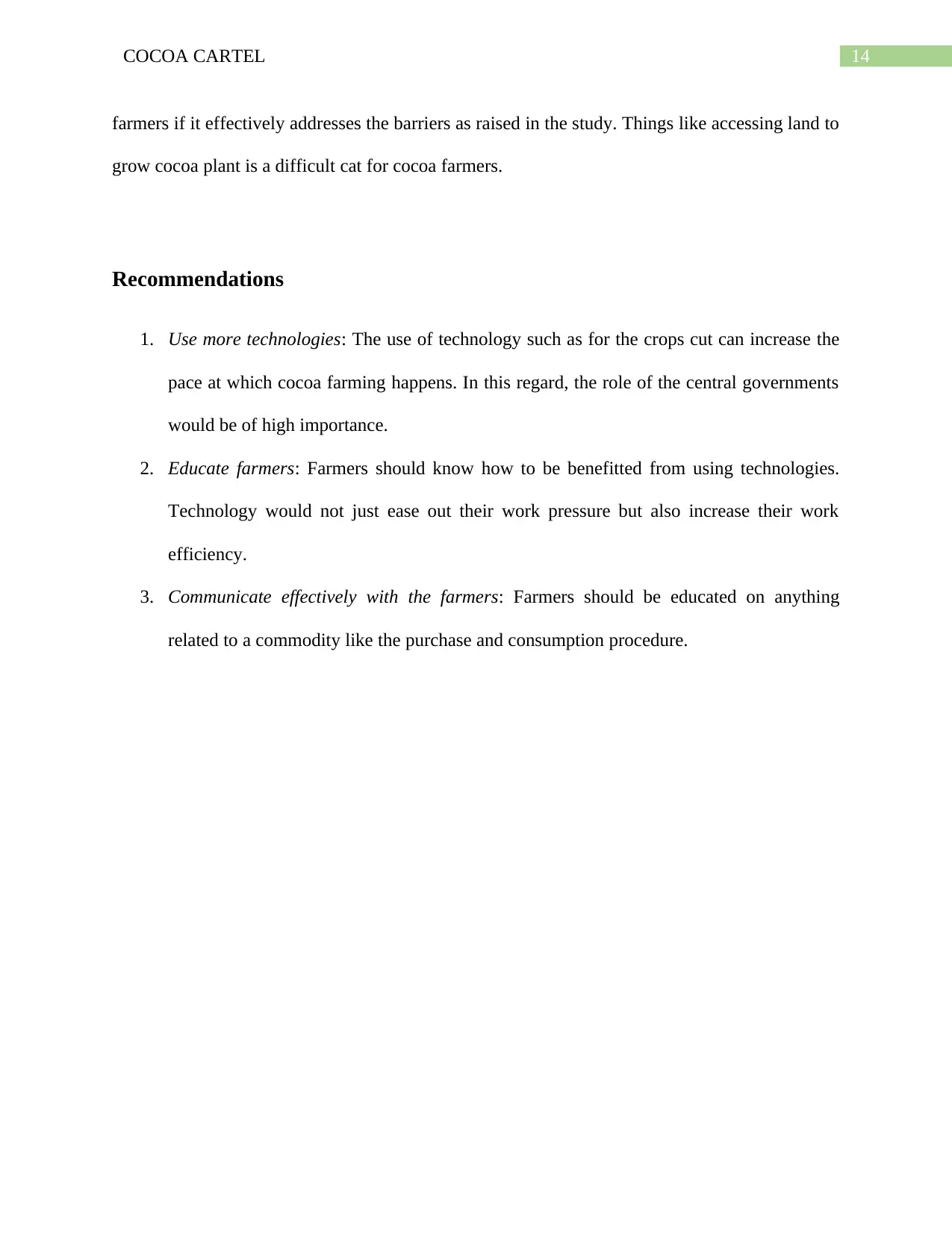
14COCOA CARTEL
farmers if it effectively addresses the barriers as raised in the study. Things like accessing land to
grow cocoa plant is a difficult cat for cocoa farmers.
Recommendations
1. Use more technologies: The use of technology such as for the crops cut can increase the
pace at which cocoa farming happens. In this regard, the role of the central governments
would be of high importance.
2. Educate farmers: Farmers should know how to be benefitted from using technologies.
Technology would not just ease out their work pressure but also increase their work
efficiency.
3. Communicate effectively with the farmers: Farmers should be educated on anything
related to a commodity like the purchase and consumption procedure.
farmers if it effectively addresses the barriers as raised in the study. Things like accessing land to
grow cocoa plant is a difficult cat for cocoa farmers.
Recommendations
1. Use more technologies: The use of technology such as for the crops cut can increase the
pace at which cocoa farming happens. In this regard, the role of the central governments
would be of high importance.
2. Educate farmers: Farmers should know how to be benefitted from using technologies.
Technology would not just ease out their work pressure but also increase their work
efficiency.
3. Communicate effectively with the farmers: Farmers should be educated on anything
related to a commodity like the purchase and consumption procedure.
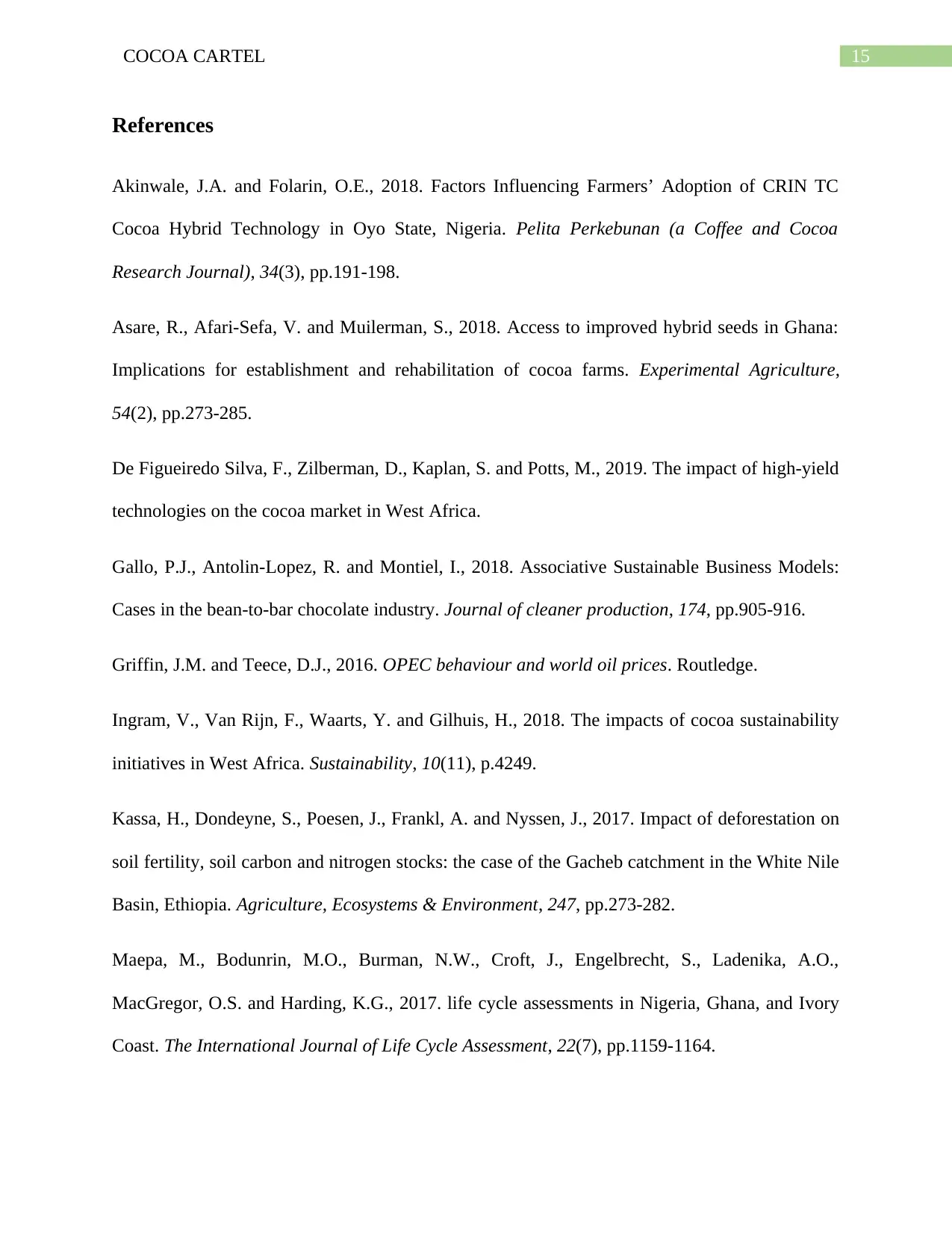
15COCOA CARTEL
References
Akinwale, J.A. and Folarin, O.E., 2018. Factors Influencing Farmers’ Adoption of CRIN TC
Cocoa Hybrid Technology in Oyo State, Nigeria. Pelita Perkebunan (a Coffee and Cocoa
Research Journal), 34(3), pp.191-198.
Asare, R., Afari-Sefa, V. and Muilerman, S., 2018. Access to improved hybrid seeds in Ghana:
Implications for establishment and rehabilitation of cocoa farms. Experimental Agriculture,
54(2), pp.273-285.
De Figueiredo Silva, F., Zilberman, D., Kaplan, S. and Potts, M., 2019. The impact of high-yield
technologies on the cocoa market in West Africa.
Gallo, P.J., Antolin-Lopez, R. and Montiel, I., 2018. Associative Sustainable Business Models:
Cases in the bean-to-bar chocolate industry. Journal of cleaner production, 174, pp.905-916.
Griffin, J.M. and Teece, D.J., 2016. OPEC behaviour and world oil prices. Routledge.
Ingram, V., Van Rijn, F., Waarts, Y. and Gilhuis, H., 2018. The impacts of cocoa sustainability
initiatives in West Africa. Sustainability, 10(11), p.4249.
Kassa, H., Dondeyne, S., Poesen, J., Frankl, A. and Nyssen, J., 2017. Impact of deforestation on
soil fertility, soil carbon and nitrogen stocks: the case of the Gacheb catchment in the White Nile
Basin, Ethiopia. Agriculture, Ecosystems & Environment, 247, pp.273-282.
Maepa, M., Bodunrin, M.O., Burman, N.W., Croft, J., Engelbrecht, S., Ladenika, A.O.,
MacGregor, O.S. and Harding, K.G., 2017. life cycle assessments in Nigeria, Ghana, and Ivory
Coast. The International Journal of Life Cycle Assessment, 22(7), pp.1159-1164.
References
Akinwale, J.A. and Folarin, O.E., 2018. Factors Influencing Farmers’ Adoption of CRIN TC
Cocoa Hybrid Technology in Oyo State, Nigeria. Pelita Perkebunan (a Coffee and Cocoa
Research Journal), 34(3), pp.191-198.
Asare, R., Afari-Sefa, V. and Muilerman, S., 2018. Access to improved hybrid seeds in Ghana:
Implications for establishment and rehabilitation of cocoa farms. Experimental Agriculture,
54(2), pp.273-285.
De Figueiredo Silva, F., Zilberman, D., Kaplan, S. and Potts, M., 2019. The impact of high-yield
technologies on the cocoa market in West Africa.
Gallo, P.J., Antolin-Lopez, R. and Montiel, I., 2018. Associative Sustainable Business Models:
Cases in the bean-to-bar chocolate industry. Journal of cleaner production, 174, pp.905-916.
Griffin, J.M. and Teece, D.J., 2016. OPEC behaviour and world oil prices. Routledge.
Ingram, V., Van Rijn, F., Waarts, Y. and Gilhuis, H., 2018. The impacts of cocoa sustainability
initiatives in West Africa. Sustainability, 10(11), p.4249.
Kassa, H., Dondeyne, S., Poesen, J., Frankl, A. and Nyssen, J., 2017. Impact of deforestation on
soil fertility, soil carbon and nitrogen stocks: the case of the Gacheb catchment in the White Nile
Basin, Ethiopia. Agriculture, Ecosystems & Environment, 247, pp.273-282.
Maepa, M., Bodunrin, M.O., Burman, N.W., Croft, J., Engelbrecht, S., Ladenika, A.O.,
MacGregor, O.S. and Harding, K.G., 2017. life cycle assessments in Nigeria, Ghana, and Ivory
Coast. The International Journal of Life Cycle Assessment, 22(7), pp.1159-1164.
Secure Best Marks with AI Grader
Need help grading? Try our AI Grader for instant feedback on your assignments.

16COCOA CARTEL
WSJ 2020. Cocoa Cartel Stirs Up Global Chocolate Market. [online] WSJ. Available at:
https://www.wsj.com/articles/new-cocoa-cartel-could-overhaul-global-chocolate-industry-
11578261601 [Accessed 17 Feb. 2020].
WSJ 2020. Cocoa Cartel Stirs Up Global Chocolate Market. [online] WSJ. Available at:
https://www.wsj.com/articles/new-cocoa-cartel-could-overhaul-global-chocolate-industry-
11578261601 [Accessed 17 Feb. 2020].
1 out of 17
Your All-in-One AI-Powered Toolkit for Academic Success.
+13062052269
info@desklib.com
Available 24*7 on WhatsApp / Email
![[object Object]](/_next/static/media/star-bottom.7253800d.svg)
Unlock your academic potential
© 2024 | Zucol Services PVT LTD | All rights reserved.
